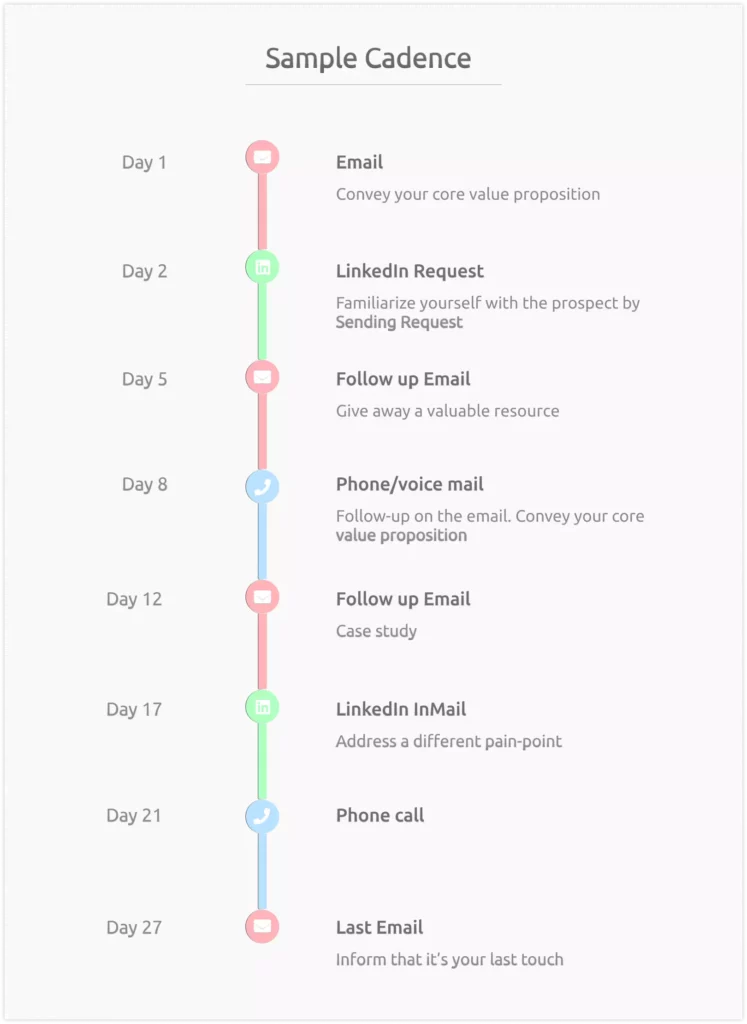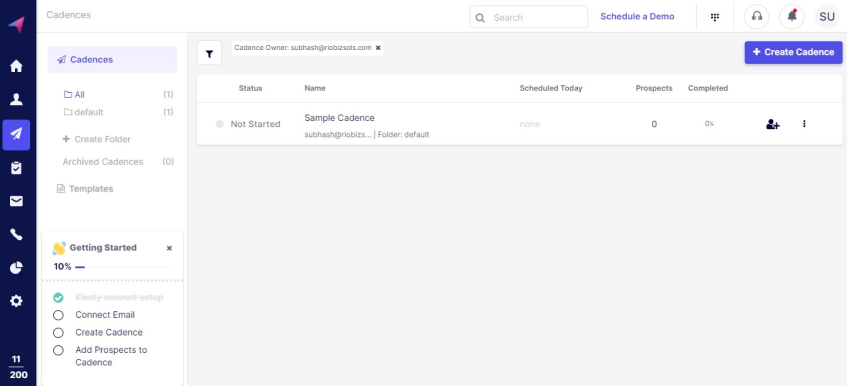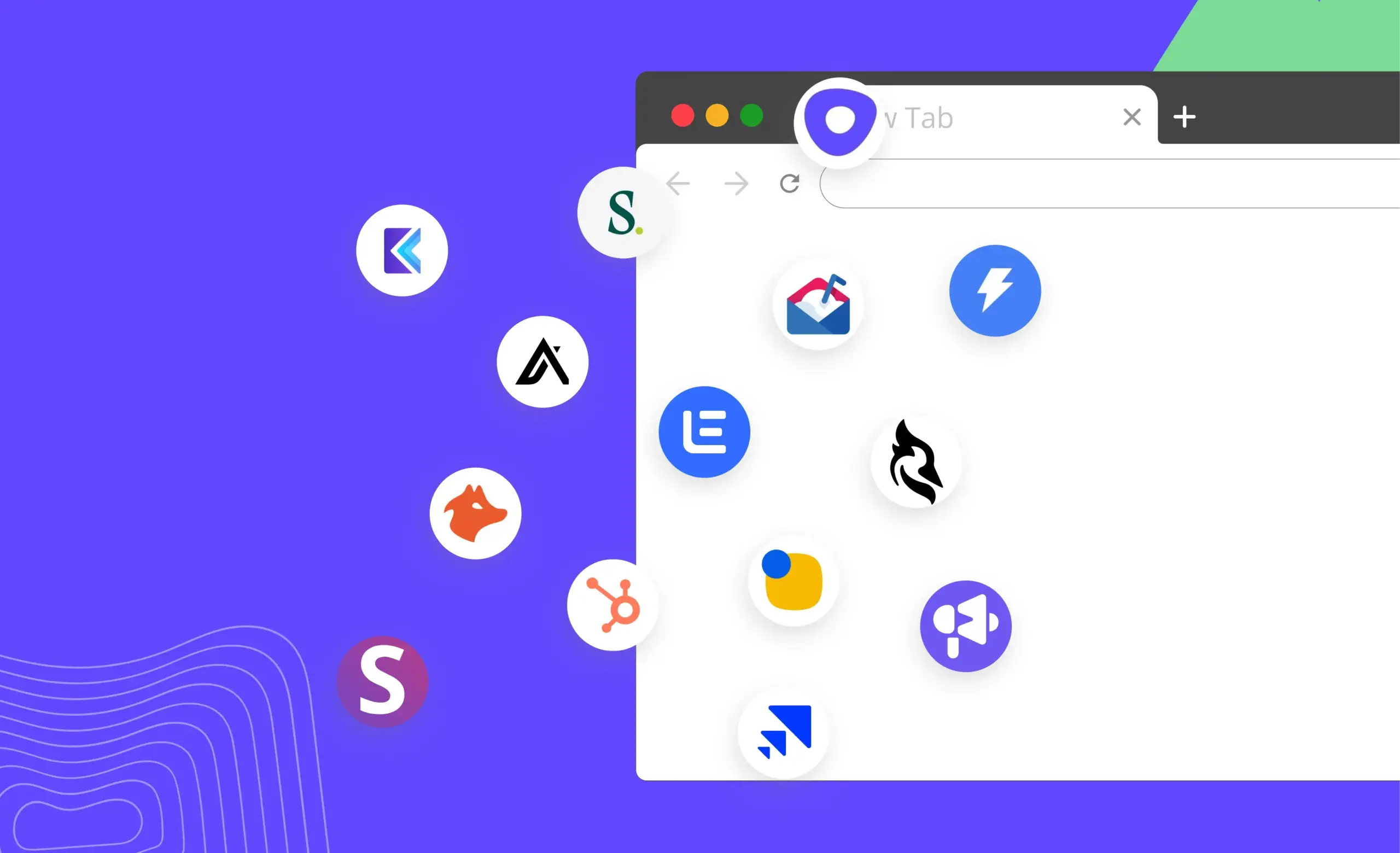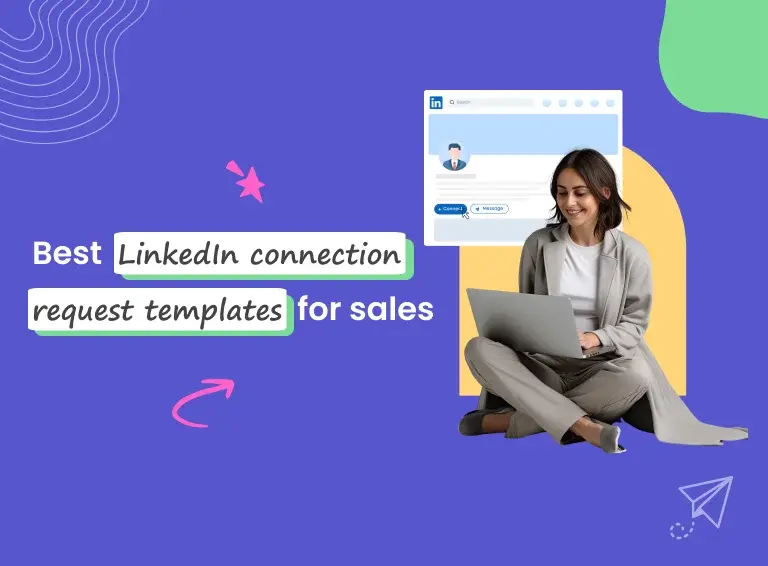If you are doing outbound sales...
Sales Cadence is the most important weapon at your disposal to keep crushing those targets month on month.
But in an attempt to use a sales cadence for quick wins, most salespeople just gather a bunch of templates or scripts and start reaching out to the prospects.
But this will be like playing an instrument without any rhythm, you will only hear raucous noise. Within a few weeks of launching the cadence - you realize that the results are dismal.
Your sales cadence should be a systematic series of touch points using the right channels, which when orchestrated should sound like a symphony. And with that, you should be able to engage with your prospects effectively at scale.
So, how do you build a sales cadence that will make you the Mozart of sales? This post has a simple 8 step framework to help you create a winning sales cadence.
What Is the Meaning of a Sales Cadence?
A Sales Cadence is a series of touchpoints designed to drive deeper engagement with your prospect in order to achieve a specific objective - the objective could be anything from scheduling a call to generating a positive response.
Irrespective of whether your prospects are cold or not, they would typically need multiple nudges/touches at each stage of the sales process to keep the deal moving forward.
A good sales cadence provides a systematic framework to ensure that each prospect gets the right nudge/touch at the right time. One can use different communication channels in a cadence such as emails, phone calls, texts, social media, etc.
The Framework To Build an Effective Sales Cadence
Below we outline an 8-step framework to building an effective sales cadence that gets results. We have split the framework broadly into three parts:
Research
- A well-designed cadence is built on the foundation of understanding your prospects. In the first few steps of the process, we guide you through establishing your cadence objective and then go about researching your prospects to understand their needs.
Planning
- The second part of the process deals with constructing your cadence. In this section, we get into the nitty-gritty of building a cadence - such as planning the number of touches, purpose of each touch, etc - along with the best copywriting practices to keep in mind while crafting your messages.
Automation
- The last section of this blog deals with automation - why should you consider automating your sales cadences and the benefits of doing it.
Sales Cadence Framework - The Research Part
1. Define Your Cadence Objective
It all begins with this question: what’s the most realistic objective you want to achieve through this cadence?
Do you want your prospects to schedule a demo with you or do you want to sign them up for a free trial of your product? Should they respond to a survey you’re undertaking or should they get on a qualification call with you?
Ideally, the purpose of your cadence should be the least intrusive next step that moves your prospects one step closer to the end goal (such as scheduling a demo, for example).
Unfortunately, most people start off with an overly ambitious goal when building their sales cadence.
Right off, they want to use the cadence to close a deal. Or schedule a call with a prospect who knows nothing about them.
The key here is to understand that a cadence alone cannot help you close a deal (unless that’s the next step) - it can only move your prospects towards the next step in the sales process.
This means that depending on the state of your prospect (cold or warm) and the problem that you solve - you need to pick the right next step to get them interested in your offering.
Starting with the objective ensures that you stay on point while devising your communication channels, email copy all the way till your call scripts, subject lines, calls-to-action (CTAs), etc.
2. Evaluate the Channels and Resources at Your Disposal
As a salesperson, trying to reach out to your prospects, there are a plethora of communication channels available to you. From emails/calls to SMS, LinkedIn (social media) and direct mail, there are multiple ways to get in touch with your prospects.
Unfortunately, most people default to a combination of emails and calls.
As much as these channels are great to connect with your prospects, they’re also heavily saturated - making it important to consider other channels. Building a balanced cadence - that gets your prospects to respond - requires an omnichannel approach.
But how do you evaluate the most suitable channel for your prospects?
The most appropriate outreach channel for a particular prospect depends upon how valuable is this prospect to you/your likely ROI.
The more valuable your prospect - the more budget you have at your disposal, the more time you can spend on each prospect and it is also likely that there will be a lesser number of prospects available for you to deal with.
For example, while dealing with an enterprise-grade account, you might want to be more personalized in your approach. So, you can try sending a direct mail with personalized swag to win your prospect’s attention first and then follow-up with a series of calls, emails, texts, social touches, etc.
On the other hand, when you’re dealing with leads of relatively low deal value - such as SMBs, for instance - you have no choice but to reach out to a large number of prospects in a short time frame without a lot of personalization.
A study conducted on how SMBs would like to be contacted found that about 79% of them chose email over any other communication channel.
If you’re targeting an SMB account - you know email should occupy a significant place in your cadence. You can then merge it with LinkedIn InMail/social touches. Generally, for a high-velocity sales model at a low Annual Contract Value (ACV), these are the most commonly used channels.
3. Understand Your Prospects
When you’re trying to start a conversation with your prospects, it’s vital to personalize your communication and craft messages that look like they’re uniquely written for each of your prospects.
How do you effectively implement compelling personalization? How do you collect useful bits of information about your prospects that help you use the right triggers in your messaging?
By adequately researching your prospects. Research is vital to understand your prospects - their goals, pain points, recent achievements, etc to develop effective messaging that will resonate with them.
There are typically two ways in which you can do research.
First, you can research each of your prospects, collect insightful details about them and go about crafting each email/message one by one.
But this method might not be practical while dealing with a large number of prospects.
When you’re prospecting at scale, the key is to batch your research. This technique will help you scale your outreach.
In this case, instead of researching your prospects one-by-one, you study them as a batch. This means that you collect the same details/facts about each of your prospects and capture this data in a tabulated format. Based on this table, you can now choose the points of customization to be used while crafting your emails.
For example, start off by picking up small groups of 5-10 prospects. Now collect 10-15 pieces of the same information across each of these groups, such as industry, geography, designation, etc. Compile the information gathered in a spreadsheet and build a data table.
You can now use this table to build a personalized email template for an array of prospects in one go, thereby immensely cutting down your time spent on composing emails.

4. Articulate Your Value Proposition
The next step in building your sales cadence is to identify the fundamental problem that you can solve for the prospects you’re targeting.
One way to find this is to see which of your existing customers best resemble your prospects - and understand them. They will tell you why your product is a good fit for your prospects.
Try to decode the problem you’re solving for these customers - what is it about your product that best appeals to them and why do they love you. What’s driving these customers to consistently buy from you?
You can do this by talking to your customers. Run a survey/campaign for these customers to understand the impact you’ve created for them and list them down. Quantify your results if possible:
1. Solved problem x.
2. Increased revenue by y.
3. Improved productivity by z.
4. Achieved outcome x, etc.
This is your ultimate value proposition - the reason your customers buy from you.
Defining your value proposition will help tighten up your messaging and speak your prospects’ language. You now know what will resonate with your audience and make them convert.
5. Evaluate All the Levers of Influence at Your Disposal
The objective of any cadence is to persuade your prospects into moving the deal forward. To influence them into taking the desired action.
As you move forward in building your cadence, think about how you can convince your prospects to do what you want. What tools do you possess to get there?
Robert B. Cialdini, in his seminal book “Influence”, puts forth six such psychological tactics to help you become a skilled persuader.
These six techniques - Reciprocation, Commitment and Consistency, Social Proof, Authority, Liking, and Scarcity - can be used in your message to persuade your prospects.
Ask yourself what levers of influence do you have that can create an impact on your prospects and prompt them to take the next step.
Can you use the Reciprocation technique and provide them with a valuable resource that makes them feel obligated to return the favor?
Do you have social proof to show that your prospects’ competitors are your happy customers or do you have anything in common with your prospects that is likely to evoke a response from them?
Figure out what tools can you use to trigger your prospects into moving forward.
Sales Cadence Framework - The Planning Part
6. Planning Your Cadence
The steps from here will help you plan and flesh out an effective sales cadence.
a) Number of Touches
As a first step, pinpoint the number of touches you’d like to have with your prospects.
List down all the resources you’ve evaluated in the previous steps to outline your sales cadence. Typically this list should include:
- The multiple value propositions you’d like to convey your prospects.
- All the levers of influence you’d like to use.
Build your cadence such that you best utilize the resources in your hand to generate a response from your prospects. Typically, it takes 8-10 touches to get your prospects to respond.
Optimize your cadence such that you deliver the value propositions you want to convey, provide a valuable resource, use the urgency technique, etc.
b) Channel Used for Each Touch
The next step is to plan the communication channel you want to use for each of your touchpoints.
Being thoughtful about the channel used for each touch will simplify the process of generating a response from your prospects.
For example, you could use a social touch to warm up your prospects (such as connect with them on LinkedIn first) and then refer this familiarity in your subsequent touch of sending an email.
c) Purpose of Each Touch
Every touch you make to connect with your prospects should have a clear purpose. Know what exactly are you trying to achieve by sending that email. Or making that phone call.
Do you want to establish familiarity with your prospects or should they try your newsletter? Do you want them to understand your value prop or simply check out your product video?
Make sure your call-to-action is aligned with the purpose of the specific touch/step.
For example, if you’re just trying to get acquainted with your prospects by sending a valuable resource, your CTA cannot be scheduling a demo call with you. Rather, just provide the download link and ask for feedback.
Similarly, if you want your prospects to sign up for your product, try addressing a pain-point they can best relate to and then provide a link to start the free trial of your product.
d) Space Out Your Touches
When you’re trying to start a conversation with your prospects, you’d want to draw a line between being persistent and annoying.
To follow-up just enough to stay on top of your prospects’ minds - and not shove them away - you’ll have to thoughtfully space out your touches.
Generally, one good practice is to make about 8-10 touches in the span of a month.
Your initial few touches can be relatively frequent and then tone down the frequency.
For example, try making 2-3 touches in the first two weeks, one of which can be a social touch. You can eventually reduce the number to 1-2 touches per week towards the end of your cadence.
Here's a sales cadence example for your reference.

7. Copywriting Best Practices
Now that you’ve put effort into research and designing your cadence, it’s time to flesh out your email copy.
Your email copy is one of the critical tools at your disposal that can get prospects to respond to you.
A good email will deliver value to your audience in a language that speaks to them and captures enough attention to get them thinking.
So how do you craft an email that works like magic?
There are several elements in an email - subject line, introduction, value prop, call-to-action, and signature - and a good email copy uses each of these elements to maximum benefit.
A lot has been written on copy already - and we don’t want to reiterate that here. Here are a few resources that serve as great primers to help you nail your email copy:
a) Subject Line:
A subject line is the first thing your prospects lay their eyes on in your email. Try making a great first impression for them to open your mail.
b) Email Body (Introduction and Value Prop) :
Your email copy sets the stage for a worthwhile relationship. Use it wisely.
- 50 Sales Follow Up Email Templates To Use In Different Sales Situations
- 5 Cold Email Templates Sumo.com Used to Grow to $5 Million
c) Call-To-Action (CTA):
A call-to-action, at the end of the mail, guides your prospect into taking the desired action. Make it compelling enough for them to take the next step.
- 10 Techniques to Nail Your Cold Email Call-to-Action (with CTA examples)
- 3 Cold Email Calls to Action that Get Responses
d) Cold Email Signature
A thoughtful cold email signature will leave a lasting impression on your prospects - strive to create a good one.
Sales Cadence Framework - The Automation Part
8. Use Sales Engagement Tools
One of the biggest barriers to successfully implementing a cadence is the scale of operation.
For example, let’s assume you want to reach out to about 50 prospects every day. That’s about 1000 prospects a month.
Now if your sales cadence consists of 10 touches - then it’s about 10k touches per month.
When you’re dealing with data points at such a scale, it’s practically not possible to track the progress of each prospect in the cadence - which is why you need automation.
A Sales Engagement tool like Klenty can help automate your sales cadences and scale your outreach efforts.
Klenty allows you to set up an automated cadence of emails and calls to better engage your prospects and nudge them into moving the deal forward.

Here are the other reasons why you may want to use automation:
a) Save Time. Enhance Productivity.
Keeping track of opens, bounces, and replies can be extremely time-consuming.
Automation makes your life easier by putting your cadence on autopilot mode - you’re only notified when a prospect responds. It takes care of all the drudgery involved in executing your cadence.
This way, you save a lot of time and focus on tasks that actually matter, such as building relationships with leads who are interested.
b) Draw Actionable Insights From the Data Collected
One of the biggest advantages of using automation is the ability to use data to tweak and improve your overall efficiency.
Automation allows you to track the engagement metrics of every cadence - how well your prospects are engaging with a given cadence.
This will help you collect adequate data about the performance of your cadences, experiment with them to identify what’s working and replicate the process across all your prospects.
Conclusion
A Sales Cadence, like any technology, is a wonderful tool. But a lot of it depends on how you use it.
In the hands of a good salesperson, it can be a main lifesaver that delivers responses and saves time. On the other hand, use it thoughtlessly - and you may end up pushing away good prospects. And have no results to show for your effort.
Use the framework provided above and the results will speak for the sales.





